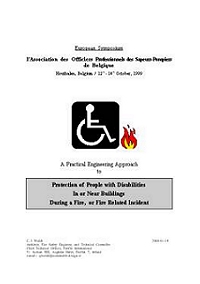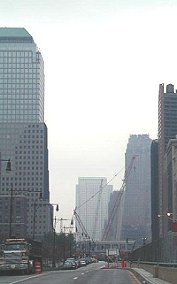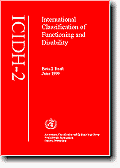




Back
to Top
Back to Top
Back to Top
Back
to Top
Back
to Top
Back
to Top
Back
to Top
Back
to Top
Back
to Top
Back
to Top
Back
to Top
Back
to Top
Back
to Top
Back
to Top
Back
to Top
|
Protection
of People with Activity Limitations from Fire
in Buildings
People
with Activity Limitations
Those people, of all ages, who are unable to
perform, independently and without aid, basic human activities or
tasks - because of a health condition or physical / mental / cognitive
/ psychological impairment of a permanent or temporary nature.
Fire Evacuation-for-All
Structural Fire Engineering after WTC 9-11 (NIST NCSTAR 1)
Accessibility-for-All
Disability Rights & Removing Physical Restrictions on Participation in Society
Disability - European Fire Research Project 2000
- 2004
(Belgium, Ireland, Italy & Sweden)
European Guideline Framework
Achievement of Equality of Opportunity & Social Inclusion
For Every Person in the European Union (E.U.)
International
Conference Papers
|

|
Houthalen, Belgium
12th - 14th October, 1999
Protection of People with Disabilities
In or Near Buildings
During a Fire,
or Fire Related Incident
Click
here to download PDF
(PDF File, 180kb)
|
Notwithstanding
the fact that different types of legislation have existed for many
years in the European Union which require that buildings and places
of work be accessible, a lack of purposeful resolve on the part
of politicians and controlling authorities at regional / member
state and local levels has ensured that, even today, countless barriers
to that accessibility are still being erected in the 'built environment'.
Furthermore, however, the non-existence of comprehensive technical
guidance on protection from fire in buildings has resulted in the
creation of a far more pervasive form of barrier to the full 'inclusion'
of the elderly and people with disabilities into the economic, cultural
and social life of the general community.

New International Classification of Functioning,
Disability and Health (ICF)
While traditional health indicators have been based on the mortality
(i.e. death) rates of populations, the ICF now dramatically shifts
the focus to 'life' and 'living' - how everyone is living with his/her
health condition(s) and how improvements can be made to ensure a
productive, fulfilling life in society. This has implications for
medical practice ; for law, social, economic, institutional, design
and spatial planning policies to improve accessibility, equal opportunity
and inclusion ; and for the protection of the rights of all individuals
and groups.
Beta-2
Draft - Full Version
July 1999
Related
Papers from the
United States Fire Administration
 |
& |
 |
Consumer Product Safety Commission
- Establishing a Relationship Between Alcohol and Casualties
of Fire (October 1999)
Click
Here To Download PDF
(PDF File, 160kb)
Executive Summary :
Though the rate has significantly decreased, the United
States continued into the late 1990's with one of the highest
fire death rates in the industrialized world. Given the
advancements in fire prevention, including public education,
building design, consumer product safety, and sophisticated
levels of the fire protection in this country, it is puzzling
to many as to why this is so. In an effort to identify the
underlying problem(s), researchers have been delving deeper
into the extent to which human behaviour affects our fire
losses.
The connection between alcohol and the ignition, detection,
and escape from the fire has been broadly examined by numerous
medical and fire protection organization studies. A series
of landmark studies undertaken by the Johns Hopkins University
and the National Bureau of Standards in the 1970's were
among the first to discover a definitive link between alcohol
consumption and fire deaths. Many studies have now confirmed
their general findings.
Alcohol intoxication may increase the risk of initiating
a fire by impairing one's judgement and co-ordination. An
intoxicated individual who is smoking may also succumb to
the depressant effects of alcohol, fall asleep and drop
a lit cigarette on upholstery or clothing. Intoxication
also acutely diminishes one's ability to detect a fire.
Under the sedative effects of alcohol, an alcohol impaired
person may fail to notice the smell of smoke, or fail to
hear a smoke alarm. Escape from a fire can be hampered by
the loss of motor co-ordination and mental clarity caused
by alcohol, even when warning signs are heeded. Furthermore,
burns are more physiologically damaging in the presence
of alcohol.
Several researchers have found that about half of all adult
fire fatalities were under the influence of alcohol at the
time of the fire. Men have been found to consistently outnumber
women among fire casualties and do so with even greater
disparity for fire victims under the influence of alcohol.
In addition, the younger adult population ( ages 15 to 34
) seems to incur the greatest number of alcohol impaired
fire casualties. Drinking behaviours that are characteristic
of various age groups and sexes may explain these findings.
Studies have also provided conclusive evidence supporting
the deleterious effects of chronic and acute alcohol abuse
on the occurrence and recovery from burn injuries. Burn
injury victims have been found to be disproportionately
likely to have been intoxicated at the time of injury or
known to be heavy drinkers. From a physiological standpoint,
burn victims with histories of alcoholism tend to have longer
hospital stays, more complications, and higher mortality
rates as a result of their burns.
Questions still remain as to the extent that alcohol affects
fire losses. How do we explain the fact that some industrialized
countries with some of the highest alcohol consumption rates
per capita, e.g. Germany and the Netherlands, have relatively
low fire death rates ? Researchers have suggested that alcohol
related unintentional injuries have more to do with alcohol
drinking patterns than the total amount of alcohol consumed
per capita. Who drinks, where they drink, what they drink,
and under what social, cultural, and religious circumstances
they drink are perhaps more significant factors than the
amount of alcohol consumed. A lone drinker at home is probably
at greater risk of a fire emergency than a group of people
drinking at a bar or restaurant. Moreover, the number of
drinks consumed in a single sitting seems to matter a great
deal.
Alcoholics have a disproportionately high rate of fire fatalities
relative to their percentage of the total population. Non-intoxicated
fire victims also may be affected by alcohol : they may
have been entrusted to the care of an alcohol impaired individual.
These fire fatalities would not be reported as related to
alcohol when blood alcohol levels ( BAL's ) are taken of
victims only. As a result, the estimated number of alcohol
related fire casualties as well as the magnitude of the
problem may be underestimated.
Smoking fires are the leading cause of fire fatalities.
The incidence of such fatal fires is higher among those
who are under the influence of alcohol and most smoking
related fire fatalities have some connection to alcohol
consumption.
In summary, there is a clear connection of alcohol and fire
fatalities. Unlike the connection between alcohol consumption
and vehicle fatalities, the connection is not often referred
to in prevention programmes, nor has much been done to address
the problem.
- Fire Risks for the Elderly (October 1999)
Click
Here To Download PDF
(PDF File, 152kb)
Executive Summary :
Older adults represent one of the highest fire risk populations
in the United States. As a result of progressive degeneration
in physical, cognitive, and emotional capabilities, older
adults present unique challenges in the fields of fire protection,
prevention, and safety. Complications associated with ageing
increase the likelihood that an elderly person will accidentally
start a fire and at the same time reduce his or her chances
of surviving it. As the nation's elderly population grows,
the fire death toll will likely rise in direct proportion
to that growth unless measures are taken to ameliorate the
risks associated with this group. The fire safety community
must address the fire safety needs of older adults or be
faced with the potential for a severe public health problem.
The key findings of this report are summarized below
:
The Fire Problem and Older Adults
People over the age of 65 are the fastest growing segment
of the American population ;
Over 1,200 Americans over the age of 65 die as a result
of a fire each year. Older adults comprise over 25 % of
fire deaths of all ages, and 30 % of fire deaths that occur
in the home ;
Fires and burns are a leading cause of deaths from unintentional
injuries among older adults ;
Residential fires injure an average of 3,000 older adults
each year ;
Fires caused by smoking are the leading cause of fire deaths
in the elderly ;
Fires caused by cooking are the leading cause of fire-related
injuries in the elderly ;
Elderly fire victims usually come in close contact with
the heat source that starts the fire ;
Adults in the age group between 65 and 75 have a fire death
rate twice that of the national average ; between 75 and
85, three times the national average ; and over 85, four
times the national average.
Fire Risks
The ageing process, with its associated illnesses and impairments,
leaves a person vulnerable to a variety of accidental injuries,
including fires and burns ;
The likelihood of experiencing a severe disability increases
with age. Impairments associated with the ageing process,
such as blindness or deafness, predispose the elderly to
accidental injuries, including fires ;
Approximately 30 % non-institutionalized older adults live
alone, placing them at higher risk for accidental injury
;
Group assisted-living facilities and nursing homes pose
unique fire risks to both their residents and firefighters
;
Nearly 20 % of older adults live at or below the poverty
line, and the relationship between poverty and fires is
a compounding fire risk ;
Many older adults take multiple medications, the interaction
of which can cause a variety of side effects, including
confusion, that may alter the decision-making process and
increase the potential for accidents ;
The impairments caused by the combination of alcohol and
prescription drugs in older adults can be significant. Such
impairments may lead to an increased likelihood of accidentally
starting a fire, not detecting a fire, and not being able
to escape a fire.
- Fire Risks for the Hearing Impaired (October 1999)
Click
Here To Download PDF
(PDF File, 66kb)
Executive Summary :
Fire safety is a much overlooked problem among people who
are deaf or hard-of-hearing. They do not receive the same
media, educational, or industry attention as the hearing
population. Many advancements in fire injury and death prevention
over the past century have not addressed the fire safety
needs of the deaf community. The most significant of those
inventions is the audible smoke alarm. Smoke alarms have
been credited with saving thousands of lives from fires
each year. Conventional alarms, however, work less well
for those who cannot hear. Additionally, traditional fire
safety messages do not address the unique needs of the deaf
community. Fire safety messages more than likely will not
reach this population due to the lack of effective distribution
channels.
By raising the level of fire safety awareness for the deaf
and hard-of-hearing community, and for the surrounding population,
we can eliminate many fire risks. Groups representing people
with hearing impairments must collaborate with the fire
service to educate each other and reduce the risks posed
by fires to non-hearing people.
The principal findings of this study are summarized below
:
Visual assessment is the primary means for people with hearing
impairments to process information vital to everyday living.
These individuals cannot rely on traditional audible smoke
alarms. They require visual alarms equipped with strobe
lights or vibration devices ;
Vibrating beds and pillows have been developed to awaken
people who are deaf or hard-of-hearing and alert them to
the presence of a fire. These beds and pillows are wired
to a smoke alarm and vibrate when the alarm is activated
;
A portion of the deaf and hard-of-hearing population is
also blind or visually impaired. Visual strobe lights are
ineffective for this group. A vibrating bed and pillow alarm
must be used instead ;
While specialized detection and alarm devices are available,
there is a dearth of information about how to obtain them.
In addition, these devices are often prohibitively expensive
;
Many people who are deaf or hard-of-hearing are not aware
of provisions in the Americans With Disabilities Act requiring
that appropriate smoke alarms be provided by landlords,
public buildings, etc. ;
Public fire education is generally neither formatted for,
nor directed to, people who are hearing impaired.
- Fire Risks for the Visually Impaired (October 1999)
Click
Here To Download PDF
(PDF File, 79kb)
Executive summary :
Blind or visually impaired people are faced with many challenges,
not the least of which is personal safety. Interaction with
an environment one cannot see creates potential health and
safety hazards. As a result, blind or visually impaired
people are at increased risk of injury and death in the
event of a fire. Depending on the severity of vision loss,
they may be more likely to ignite a fire accidentally through
common household activities, while they are less likely
to extinguish or escape one. Further, a blind or visually
impaired individual is highly vulnerable to sustaining burns
by attempting to suppress a small fire.
Practicing fire safety is the most effective means for a
blind or visually impaired person to improve his or her
chances of surviving a fire. For example, by planning and
practicing an escape plan, a blind or visually impaired
person can escape to safety, in the event of an actual emergency,
with little time lost searching and feeling for an exit.
The same general fire safety tips targeted at the seeing
population address the needs of the blind or visually impaired.
Unfortunately, blind or visually impaired people often have
been overlooked by public fire education campaigns. Innovative
mechanisms by which to disseminate these life-saving messages
must be sought in order to raise awareness and foster fire
safety practices in the blind and visually impaired community.
The most important findings of this report are as follows
:
During an emergency, the senses on which visually impaired
or blind individuals depend may be overwhelmed ;
High-decibel smoke alarms make it difficult for the blind
individual to process audible clues and instructions effectively
;
Many buildings are not equipped with Braille or tactile
signage for the visually impaired, hindering the individual's
ability to escape because of lack of directions ;
As they may not be able to process visual indicators of
fire, individuals with visual impairments are at an increased
risk for accidents involving fires and burn injuries ;
Public fire education is not generally formatted for, nor
directed to, the blind or visually impaired ;
Practicing fire safety, rather than using improved fire
technology, is the most effective means by which blind or
visually impaired people can improve their chances of surviving
a fire.
- Fire Risks for the Mobility Impaired (October 1999)
Click
Here To Download PDF
(PDF File, 66kb)
Executive Summary :
People with mobility impairments are faced with many challenges
in life. Personal safety, especially fire safety, is one
challenge that many perceive as an obstacle. It does not
have to be this way. By being aware of one's own special
capabilities and following fire safety practices tailored
to certain needs the mobility impaired person can lead a
fire-safe life.
Mainstream fire safety education and fire protection devices
are designed primarily with the able-bodied person in mind.
Thus, a scarcity of fire safety knowledge exists within
both the mobility impaired community and the fire service.
Both groups must work to educate each other to decrease
fire-related losses and injuries.
The principal findings of this study are summarized below
:
People with mobility impairments represent a segment of
the population with one of the highest risks of dying in
a fire ;
The fire safety needs of people with mobility impairments
are not addressed through mainstream public fire and life
safety education ;
Fire safety engineering has not adequately addressed the
capabilities of people with mobility impairments ;
Typical home construction may present people with disabilities
with unnecessary impediments to escape ;
The mobility impaired community is growing ; ?
Mobility impairments hinder attempts by the disabled not
only to escape fires, but also to confine or extinguish
small fires.
- Firefighter Personnel Accountability System Technology
Assessment (March 2000)
Click
Here To Download PDF
(PDF File, 560kb)
- Socio-Economic Factors & the Incidence of Fire
(June, 1997)
Click
Here To Download PDF
(PDF File, 212kb)
- Fire Safety Checklist for Elderly People
Click
Here To Download PDF
(PDF File, 284kb)
- Child-Resistant Lighters
Click
Here To Download PDF
(PDF File, 73kb)
- Automatic Sprinklers (1997)
A ten year study in Scottsdale, Arizona, USA
Click
Here To Download PDF
(PDF File, 5,455kb)

|
You will need
Adobe Acrobat Reader to view the PDF files. Accessibility
of PDF for people with disabilities |
|
|












